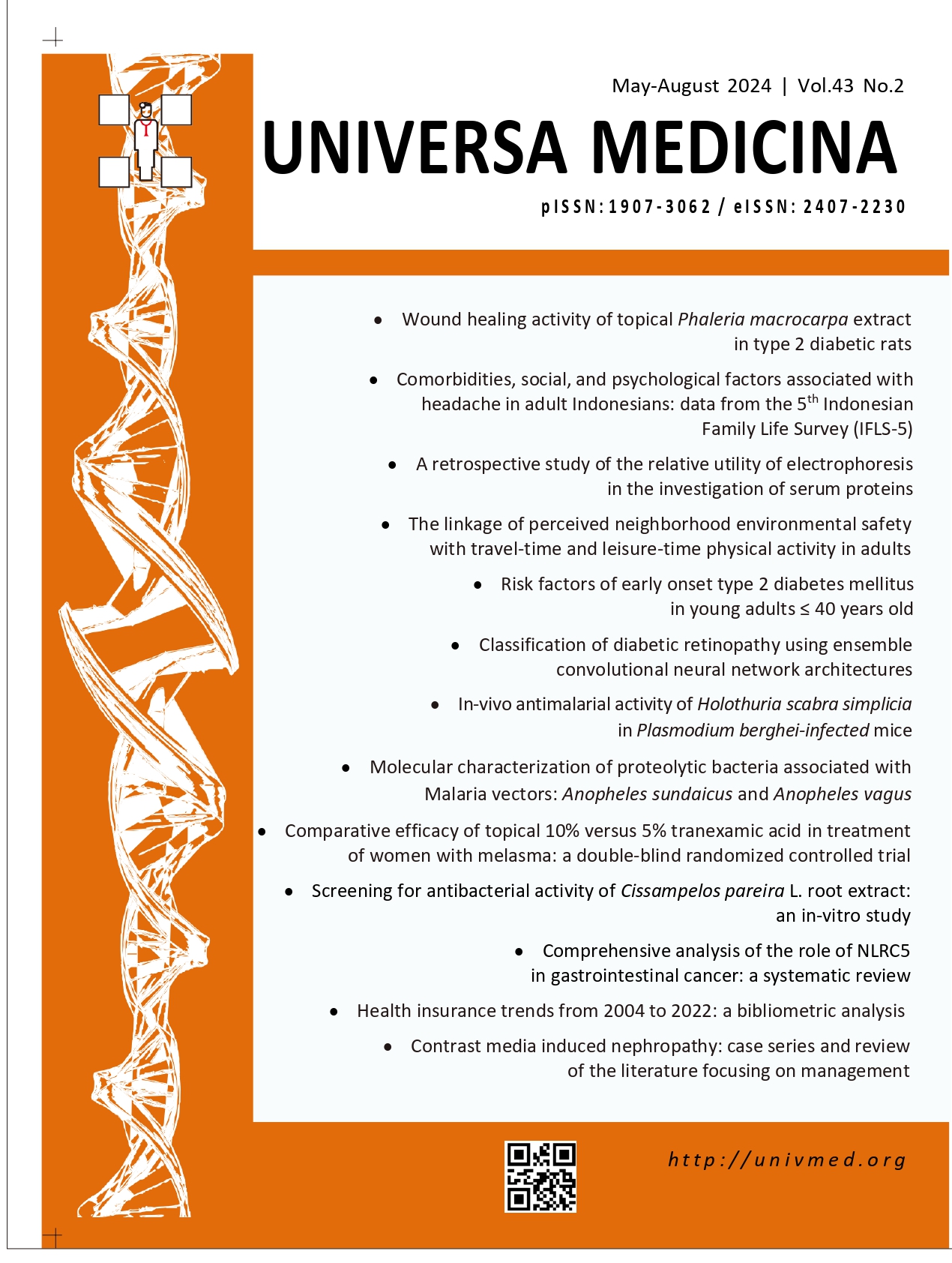Contrast media induced nephropathy: case series and review of the literature focusing on management
Main Article Content
Abstract
Background
Contrast media administration during diagnostic and invasive procedures in high risk patients for nephrotoxicity is a common problem in clinical practice. Radiological procedures using intravascular iodinated contrast injection media have been widely used for therapeutic purposes. Contrast-induced nephropathy (CIN) is a serious complication of angiographic procedures and results from administration of contrast media (CM), which increases morbidity and mortality rates.
Case Description We present these 10 cases with high risk of CIN and diverse characteristics. A new generation iso-osmolar CM (iodixanol) was administered in these cases. Three of the cases experienced CIN events, where one patient experienced an improvement in his condition, but two other patients experienced complications and eventually died due to the underlying disease. The other 6 cases did not experience CIN after receiving CM, which was due to better preparation beforehand. One patient with a history of regular hemodialysis, underwent immediate post-operative dialysis with CM, and no evaluation of the incidence of CIN was required.
Conclusion
Of the 10 cases observed, 3 of them experienced CIN which was caused by the severity of the patient’s condition and lack of preparation time before the CM procedure. Management of CIN is complex, starting from the pre-treatment evaluation until 72 hours or more after the CM procedure. This case series suggests that even new generation CM (including iodixanol) may be severely nephrotoxic, when administered to high risk patients. The amount of CM given must be below the maximum limit and adjusted to the patient’s condition. Additionally, we review the complex mechanisms involved in management of CM nephrotoxicity.
Article Details
Issue
Section

This work is licensed under a Creative Commons Attribution-NonCommercial-ShareAlike 4.0 International License.
The journal allows the authors to hold the copyright without restrictions and allow the authors to retain publishing rights without restrictions.
How to Cite
References
Silver SA, Shah PM, Chertow GM, Harel S, Wald R, Harel Z. Risk prediction models for contrast induced nephropathy: systematic review. BMJ 2015;351:h4395. doi: 10.1136/bmj.h4395. Erratum in: BMJ 2015;351:h5401. doi: 10.1136/bmj.h5401.
Pomara C, Pascale N, Maglietta F, Neri M, Riezzo I, Turillazzi E. Use of contrast media in diagnostic imaging: medico-legal considerations. Radiol Medica 2015;120:802-9. doi: 10.1007/s11547-015-0549-6.
Knuuti J, Bengel F, Bax JJ, et al. Risks and benefits of cardiac imaging: an analysis of risks related to imaging for coronary artery disease. Eur Heart J 2014;35:633-8. doi: 10.1093/eurheartj/eht512.
Rear R, Bell RM, Hausenloy DJ. Contrast-induced nephropathy following angiography and cardiac interventions. Heart 2016;102:638-48. doi: 10.1136/heartjnl-2014-306962.
Ozkok S, Ozkok A. Contrast-induced acute kidney injury: a review of practical points. World J Nephrol 2017;6:86. doi: 10.5527/wjn.v6.i3.86.
Mohammed NMA, Mahfouz A, Achkar K, Rafie IM, Hajar R. Contrast‑induced nephropathy. Heart Views 2013;14:106-12. doi: 10.4103/1995-705X.125926.
Reza Khatami SM. Risks and complications of coronary angiography: contrast related complications. In: Kiraç SF, editor. Advances in the diagnosis of coronary atherosclerosis. IntechOpen;2011.pp.121-39. doi: 10.5772/20144
Kidney Disease Improving Global Outcomes (KDIGO) CKD Work Group. KDIGO 2024 Clinical practice guideline for the evaluation and management of chronic kidney disease. Kidney Int 2024; 105 (Suppl 4S): S117–S314. DOI: https://doi.org/10.1016/j.kint.2023.10.018.
Ali A, Bhan C, Malik MB, Ahmad MQ, Sami SA. The prevention and management of contrast-induced acute kidney injury: a mini-review of the literature. Cureus 2018;10:1-3. doi: 10.7759/cureus.3284.
Owen RJ, Hiremath S, Myers A, Fraser-Hill M, Barrett BJ. Canadian Association of Radiologists consensus guidelines for the prevention of contrast-induced nephropathy: update 2012. Can Assoc Radiol J 2014;65:96-105. doi: 10.1016/j.carj.2012.11.002.
Mehran R, Dangas GD, Weisbord SD. Contrast-associated acute kidney injury. N Engl Med J 2019;380:2146-55. doi:10.1056/NEJMra1805256.
Vijay S, Tiwari B, Singh A. Contrast induced nephropathy: pathophysiology and prevention. Heart India 2013;1:39. doi:10.4103/2321-449x.118580.
Faggioni M, Mehran R. Preventing contrast-induced renal failure: a guide. Interv Cardiol 2016;11:98-104. doi: 10.15420/icr.2016:10:2.
McCullough PA, Choi JP, Feghali GA, et al. Contrast-induced acute kidney injury. J Am Coll Cardiol 2016;68:1465-73. doi:10.1016/j.jacc.2016.05.099.
Aoun J, Nicolas D, Brown JR, Jaber BL. Maximum allowable contrast dose and prevention of acute kidney injury following cardiovascular procedures. Curr Opin Nephrol Hypertens 2019;27:121–9. doi:10.1016/j.gde.2016.03.011.
Gupta S, Goya P, Gupta N, Sawhney H, Kumar V. Contrast-induced nephropathy: current practice. J Urol Nephrol Stud 2018;1:9-19. doi:10.32474/juns.2018.01.000103.
Abellás-Sequeiros RA, Raposeiras-Roubín S, Abu-Assi E, et al. Mehran contrast nephropathy risk score: is it still useful 10 years later? J Cardiol 2016;67:262-7. doi: 10.1016/j.jjcc.2015.05.007.
Modi K, Padala SA, Gupta M. Contrast-induced nephropathy. Treasure Island (FL): StatPearls Publishing; 2024.
Susantitaphong P, Eiam-Ong S. Nonpharmacological strategies to prevent contrast-induced acute kidney injury. Biomed Res Int 2014;2014:463608. doi: 10.1155/2014/463608.S
Sales GTM, Foresto RD. Drug-induced nephrotoxicity. Rev Assoc Med Bras (1992) 2020;66 Suppl 1(Suppl 1):s82-s90. doi: 10.1590/1806-9282.66.S1.82.
Deng CX. Contrast-induced nephropathy treatment & management. Medsacape;2024.


